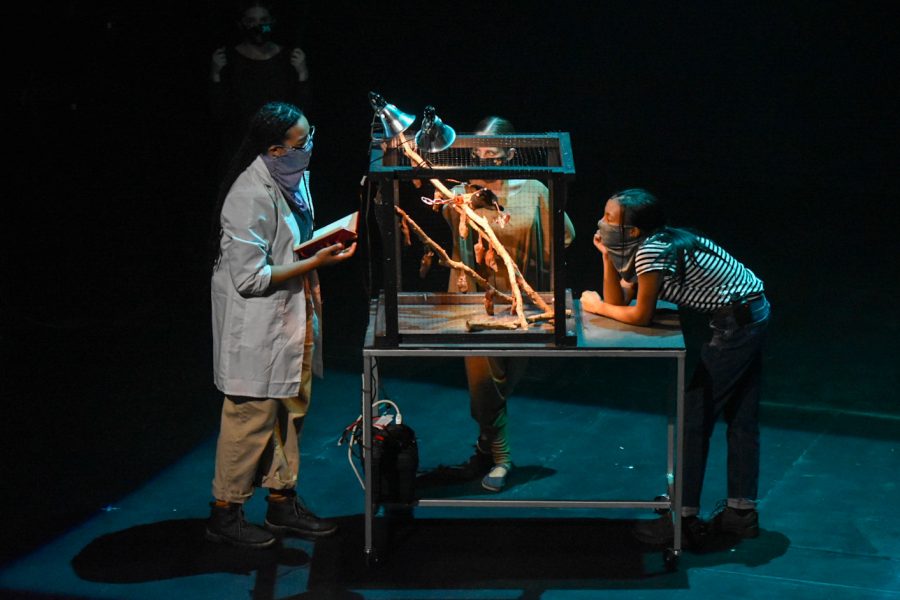Pitt Stages goes ‘Somewhere’ with sustainability
Pitt Stages debuted Maria Treviño Orta’s “Somewhere” at the Charity Randall Theatre on Saturday. The play runs until Oct. 22.
October 21, 2021
Pitt Stages is kicking off its in-person productions at Charity Randall Theatre for the first time since spring 2020, and the much-anticipated return to live performance at Pitt comes with an important message about mindfulness and sustainability.
The debut show “Somewhere,” written by Marisela Treviño Orta, takes place in a not-too-distant future. Climate change has killed most of the insects and continues to make its way down the food chain, threatening all life on Earth. The main characters, scientist Cassandra and her sister Sasha, track butterfly migration patterns in hopes of saving the insect population.
The faculty, staff and students of Pitt Stages have continuously adapted to the restrictions of the COVID-19 pandemic. In the production, the audience is confronted with topics familiar to us, like the environmental crisis, mysterious illness and a drastically different way of life, perfect for mitigating some of the challenges brought on by COVID-19 protocols.
Ricardo Vila-Roger, director of this fall’s production, said “Somewhere” offered a plotline that conveniently fit in with mask regulations onstage and was one of the main reasons he chose the play.
“Among the many things that are happening, it is a dust bowl,” Vila-Roger said. “Since the plants are dying, there is no root system to keep the dirt settled, so everyone has to wear masks and so we thought, ‘Hey that works out!’ because we have to do that anyway.”
Theater is in an art form heavily reliant on expression and emotion. Karen Gilmer, the costume designer for “Somewhere,” said though it is great to be back in person, performing with masks has its downfalls.
“I’m a very facial person and that to me is a part of storytelling,” Gilmer said. “I feel that we are losing, by being back in person and using masks, we are losing an essential part of how theater came to be with the Greek masks and storytelling.”
While masks have posed challenges for Gilmer, she found a way to enjoy adapting the masks to fit each character. Gilmer said for people on the farm, she used neutral-colored masks because of their connection to nature, while she used neck gaiters for the two traveling sisters to distinguish them as outsiders.
“Masks are part of costume design and so that for me is an extra layer of design that will go away in hopefully the foreseeable future,” Gilmer said. “But for right now it is something that has to be a part of the storytelling and how it works to not become distracting.”
Besides working with mask policies, Pitt Stages also took measures with this production to improve sustainability efforts. The department reused previous costumes from stock and constructed set pieces that will be repurposed for future productions in the program.
Gianni Downs, scenic designer for “Somewhere,” said set design is not generally concerned with environmental consciousness, but the theater department at Pitt hopes to change that starting this semester.
“Most of the time, we built a show, and the entire thing is thrown out afterward because it is specific to that theater, and that show and that production,” Downs said. “So for us, it was important that whatever we built, it was something that would live on beyond this time, and if we didn’t have to build something we wouldn’t build it.”
Downs said several recycled materials were part of the simple set, including trees from Pitt’s groundskeepers, a door from Facebook Marketplace and butterflies made from recycled plastic. Everything that was not recycled was built so that it could be used in future productions.
“We tried to stay out of the way of the script and out of the way of the actors … For this specific show there was so little we wanted on the stage that we didn’t have to source much,” Downs said. “It was really the screen door and those trees and then everything else that was part of the scenery was built into stock.”
Costumes are another significant source of wastefulness in theater. Gillmer said the department was able to reuse almost all of the clothes they had in stock by altering and dyeing them, while the remainder was obtained through thrifting and limited buying.
“I would say around 96% of the costumes were from stock that I altered in some way and a lot of those ways was through color,” Gilmer said. “The ones that weren’t, I went shopping at Goodwill and places like that.”
Vila-Roger has mainly directed shows that discussed race, ethnicity and identity. He said it was exciting to direct a show about climate change and apply the theme of mindfulness to the rest of the production process.
“This is the first time I’ve directed a play that has more to do with environmental issues and it’s something I care about,” Vila-Roger said. “So it’s been exciting to tackle that, and also as a department figure out how we can since theater is a wasteful artform … take a look inward and say, ‘What are more sustainable ways we can do this?’”
Vila-Roger said for this production, he was eager to rehearse with the cast members and finally be able to showcase all of the department’s hard work for an in-person audience.
“It’s the rehearsal process that I was most looking forward to, just being in the room with folks and figuring out who these people are and figuring out the best way that we can tell the story with the people that we have,” Vila-Roger said. “To me, that has been the most joyous part, and then getting to share this work we’ve done with an audience is just icing on the cake.”



